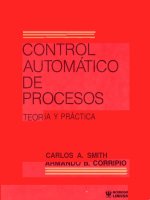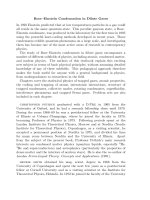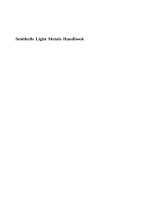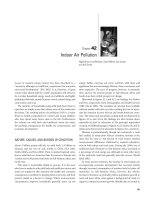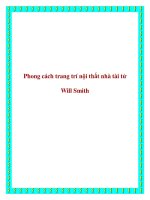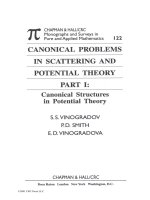PreAlgebra lynn marecek maryanne smith
Bạn đang xem bản rút gọn của tài liệu. Xem và tải ngay bản đầy đủ của tài liệu tại đây (22.92 MB, 1,146 trang )
www.pdfgrip.com
Prealgebra
SENIOR CONTRIBUTING AUTHORS
LYNN MARECEK, SANTA ANA COLLEGE
MARYANNE ANTHONY-SMITH, FORMERLY OF SANTA ANA COLLEGE
www.pdfgrip.com
OpenStax
Rice University
6100 Main Street MS-375
Houston, Texas 77005
To learn more about OpenStax, visit .
Individual print copies and bulk orders can be purchased through our website.
©2017 Rice University. Textbook content produced by OpenStax is licensed under a Creative Commons
Attribution 4.0 International License (CC BY 4.0). Under this license, any user of this textbook or the textbook
contents herein must provide proper attribution as follows:
-
-
-
-
If you redistribute this textbook in a digital format (including but not limited to PDF and HTML), then you
must retain on every page the following attribution:
“Download for free at />If you redistribute this textbook in a print format, then you must include on every physical page the
following attribution:
“Download for free at />If you redistribute part of this textbook, then you must retain in every digital format page view (including
but not limited to PDF and HTML) and on every physical printed page the following attribution:
“Download for free at />If you use this textbook as a bibliographic reference, please include
in your citation.
For questions regarding this licensing, please contact
Trademarks
The OpenStax name, OpenStax logo, OpenStax book covers, OpenStax CNX name, OpenStax CNX logo,
OpenStax Tutor name, Openstax Tutor logo, Connexions name, Connexions logo, Rice University name, and
Rice University logo are not subject to the license and may not be reproduced without the prior and express
written consent of Rice University.
PRINT BOOK ISBN-10
PRINT BOOK ISBN-13
PDF VERSION ISBN-10
PDF VERSION ISBN-13
Revision Number
Original Publication Year
1-938168-99-2
978-1-938168-99-4
1-947172-00-X
978-1-947172-00-5
PA-2016-003(03/17)-LC
2016
www.pdfgrip.com
OPENSTAX
OpenStax provides free, peer-reviewed, openly licensed textbooks for introductory college and Advanced Placement®
courses and low-cost, personalized courseware that helps students learn. A nonprofit ed tech initiative based at Rice
University, we’re committed to helping students access the tools they need to complete their courses and meet their
educational goals.
RICE UNIVERSITY
OpenStax, OpenStax CNX, and OpenStax Tutor are initiatives of Rice University. As a leading research university with a
distinctive commitment to undergraduate education, Rice University aspires to path-breaking research, unsurpassed
teaching, and contributions to the betterment of our world. It seeks to fulfill this mission by cultivating a diverse community
of learning and discovery that produces leaders across the spectrum of human endeavor.
FOUNDATION SUPPORT
OpenStax is grateful for the tremendous support of our sponsors. Without their strong engagement, the goal
of free access to high-quality textbooks would remain just a dream.
Laura and John Arnold Foundation (LJAF) actively seeks opportunities to invest in organizations and
thought leaders that have a sincere interest in implementing fundamental changes that not only
yield immediate gains, but also repair broken systems for future generations. LJAF currently focuses
its strategic investments on education, criminal justice, research integrity, and public accountability.
The William and Flora Hewlett Foundation has been making grants since 1967 to help solve social
and environmental problems at home and around the world. The Foundation concentrates its
resources on activities in education, the environment, global development and population,
performing arts, and philanthropy, and makes grants to support disadvantaged communities in the
San Francisco Bay Area.
Calvin K. Kazanjian was the founder and president of Peter Paul (Almond Joy), Inc. He firmly believed
that the more people understood about basic economics the happier and more prosperous they
would be. Accordingly, he established the Calvin K. Kazanjian Economics Foundation Inc, in 1949 as a
philanthropic, nonpolitical educational organization to support efforts that enhanced economic
understanding.
Guided by the belief that every life has equal value, the Bill & Melinda Gates Foundation works to
help all people lead healthy, productive lives. In developing countries, it focuses on improving
people’s health with vaccines and other life-saving tools and giving them the chance to lift
themselves out of hunger and extreme poverty. In the United States, it seeks to significantly
improve education so that all young people have the opportunity to reach their full potential. Based
in Seattle, Washington, the foundation is led by CEO Jeff Raikes and Co-chair William H. Gates Sr.,
under the direction of Bill and Melinda Gates and Warren Buffett.
The Maxfield Foundation supports projects with potential for high impact in science, education,
sustainability, and other areas of social importance.
Our mission at The Michelson 20MM Foundation is to grow access and success by eliminating
unnecessary hurdles to affordability. We support the creation, sharing, and proliferation of more
effective, more affordable educational content by leveraging disruptive technologies, open
educational resources, and new models for collaboration between for-profit, nonprofit, and public
entities.
The Bill and Stephanie Sick Fund supports innovative projects in the areas of Education, Art, Science
and Engineering.
www.pdfgrip.com
Give $5 or more
to OpenStax and
we’ll send you a
sticker!
OpenStax is a nonprofit initiative,
which means that every dollar you
give helps us maintain and grow our
library of free textbooks.
I like free textbooks
and I cannot lie.
If you have a few dollars to spare,
visit OpenStax.org/give to donate.
We’ll send you an OpenStax sticker
to thank you for your support!
Access. The future of education.
OpenStax.org
www.pdfgrip.com
Table of Contents
Preface
1
Whole Numbers
1.1
1.2
1.3
1.4
1.5
2
6
7
183
273
Visualize Fractions 273
Multiply and Divide Fractions 297
Multiply and Divide Mixed Numbers and Complex Fractions 317
Add and Subtract Fractions with Common Denominators 330
Add and Subtract Fractions with Different Denominators 342
Add and Subtract Mixed Numbers 364
Solve Equations with Fractions 380
407
Decimals 407
Decimal Operations 426
Decimals and Fractions 445
Solve Equations with Decimals 459
Averages and Probability 468
Ratios and Rate 481
Simplify and Use Square Roots 494
Percents
6.1
6.2
6.3
6.4
6.5
101
Introduction to Integers 183
Add Integers 201
Subtract Integers 216
Multiply and Divide Integers 236
Solve Equations Using Integers; The Division Property of Equality
Decimals
5.1
5.2
5.3
5.4
5.5
5.6
5.7
7
Use the Language of Algebra 101
Evaluate, Simplify, and Translate Expressions 121
Solving Equations Using the Subtraction and Addition Properties of Equality
Find Multiples and Factors 149
Prime Factorization and the Least Common Multiple 163
Fractions
4.1
4.2
4.3
4.4
4.5
4.6
4.7
5
Introduction to Whole Numbers
Add Whole Numbers 24
Subtract Whole Numbers 40
Multiply Whole Numbers 55
Divide Whole Numbers 73
Integers
3.1
3.2
3.3
3.4
3.5
4
7
The Language of Algebra
2.1
2.2
2.3
2.4
2.5
3
1
517
Understand Percent 517
Solve General Applications of Percent 534
Solve Sales Tax, Commission, and Discount Applications
Solve Simple Interest Applications 560
Solve Proportions and their Applications 570
The Properties of Real Numbers
7.1
7.2
7.3
7.4
7.5
Rational and Irrational Numbers 595
Commutative and Associative Properties
Distributive Property 617
Properties of Identity, Inverses, and Zero
Systems of Measurement 640
595
604
629
www.pdfgrip.com
546
250
135
8
Solving Linear Equations
8.1
8.2
8.3
8.4
9
Solve Equations Using the Subtraction and Addition Properties of Equality 665
Solve Equations Using the Division and Multiplication Properties of Equality 679
Solve Equations with Variables and Constants on Both Sides 687
Solve Equations with Fraction or Decimal Coefficients 705
Math Models and Geometry
9.1
9.2
9.3
9.4
9.5
9.6
9.7
10
721
Use a Problem Solving Strategy 721
Solve Money Applications 736
Use Properties of Angles, Triangles, and the Pythagorean Theorem
Use Properties of Rectangles, Triangles, and Trapezoids 768
Solve Geometry Applications: Circles and Irregular Figures 797
Solve Geometry Applications: Volume and Surface Area 809
Solve a Formula for a Specific Variable 830
Polynomials
10.1
10.2
10.3
10.4
10.5
10.6
11
665
Add and Subtract Polynomials 855
Use Multiplication Properties of Exponents 866
Multiply Polynomials 881
Divide Monomials 895
Integer Exponents and Scientific Notation 915
Introduction to Factoring Polynomials 933
Graphs
11.1
11.2
11.3
11.4
855
955
Use the Rectangular Coordinate System
Graphing Linear Equations 978
Graphing with Intercepts 996
Understand Slope of a Line 1013
A
Cumulative Review
B
Powers and Roots Tables
C
Geometric Formulas
Index
955
1051
1057
1061
1137
This OpenStax book is available for free at />
www.pdfgrip.com
749
Preface
1
PREFACE
Welcome to Prealgebra, an OpenStax resource. This textbook was written to increase student access to high-quality
learning materials, maintaining highest standards of academic rigor at little to no cost.
About OpenStax
OpenStax is a nonprofit based at Rice University, and it’s our mission to improve student access to education. Our first
openly licensed college textbook was published in 2012, and our library has since scaled to over 20 books for college
and AP® Courses used by hundreds of thousands of students. Our adaptive learning technology, designed to improve
learning outcomes through personalized educational paths, is being piloted in college courses throughout the country.
Through our partnerships with philanthropic foundations and our alliance with other educational resource organizations,
OpenStax is breaking down the most common barriers to learning and empowering students and instructors to succeed.
About OpenStax Resources
Customization
Prealgebra is licensed under a Creative Commons Attribution 4.0 International (CC BY) license, which means that you can
distribute, remix, and build upon the content, as long as you provide attribution to OpenStax and its content contributors.
Because our books are openly licensed, you are free to use the entire book or pick and choose the sections that are most
relevant to the needs of your course. Feel free to remix the content by assigning your students certain chapters and
sections in your syllabus, in the order that you prefer. You can even provide a direct link in your syllabus to the sections in
the web view of your book.
Instructors also have the option of creating a customized version of their OpenStax book. The custom version can be
made available to students in low-cost print or digital form through their campus bookstore. Visit your book page on
openstax.org for more information.
Errata
All OpenStax textbooks undergo a rigorous review process. However, like any professional-grade textbook, errors
sometimes occur. Since our books are web based, we can make updates periodically when deemed pedagogically
necessary. If you have a correction to suggest, submit it through the link on your book page on openstax.org. Subject
matter experts review all errata suggestions. OpenStax is committed to remaining transparent about all updates, so you
will also find a list of past errata changes on your book page on openstax.org.
Format
You can access this textbook for free in web view or PDF through openstax.org.
About Prealgebra
Prealgebra is designed to meet scope and sequence requirements for a one-semester prealgebra course. The text
introduces the fundamental concepts of algebra while addressing the needs of students with diverse backgrounds and
learning styles. Each topic builds upon previously developed material to demonstrate the cohesiveness and structure of
mathematics.
Students who are taking Basic Mathematics and Prealgebra classes in college present a unique set of challenges. Many
students in these classes have been unsuccessful in their prior math classes. They may think they know some math, but
their core knowledge is full of holes. Furthermore, these students need to learn much more than the course content. They
need to learn study skills, time management, and how to deal with math anxiety. Some students lack basic reading and
arithmetic skills. The organization of Prealgebra makes it easy to adapt the book to suit a variety of course syllabi.
Coverage and Scope
Prealgebra follows a nontraditional approach in its presentation of content. The beginning, in particular, is presented as a
sequence of small steps so that students gain confidence in their ability to succeed in the course. The order of topics was
carefully planned to emphasize the logical progression throughout the course and to facilitate a thorough understanding
of each concept. As new ideas are presented, they are explicitly related to previous topics.
Chapter 1: Whole Numbers
Each of the four basic operations with whole numbers—addition, subtraction, multiplication, and division—is
modeled and explained. As each operation is covered, discussions of algebraic notation and operation signs,
translation of algebraic expressions into word phrases, and the use the operation in applications are included.
Chapter 2: The Language of Algebra
Mathematical vocabulary as it applies to the whole numbers is presented. The use of variables, which
distinguishes algebra from arithmetic, is introduced early in the chapter, and the development of and practice
with arithmetic concepts use variables as well as numeric expressions. In addition, the difference between
expressions and equations is discussed, word problems are introduced, and the process for solving one-step
equations is modeled.
www.pdfgrip.com
2
Preface
Chapter 3: Integers
While introducing the basic operations with negative numbers, students continue to practice simplifying,
evaluating, and translating algebraic expressions. The Division Property of Equality is introduced and used to solve
one-step equations.
Chapter 4: Fractions
Fraction circles and bars are used to help make fractions real and to develop operations on them. Students
continue simplifying and evaluating algebraic expressions with fractions, and learn to use the Multiplication
Property of Equality to solve equations involving fractions.
Chapter 5: Decimals
Basic operations with decimals are presented, as well as methods for converting fractions to decimals and vice
versa. Averages and probability, unit rates and unit prices, and square roots are included to provide opportunities
to use and round decimals.
Chapter 6: Percents
Conversions among percents, fractions, and decimals are explored. Applications of percent include calculating
sales tax, commission, and simple interest. Proportions and solving percent equations as proportions are
addressed as well.
Chapter 7: The Properties of Real Numbers
The properties of real numbers are introduced and applied as a culmination of the work done thus far, and to
prepare students for the upcoming chapters on equations, polynomials, and graphing.
Chapter 8: Solving Linear Equations
A gradual build-up to solving multi-step equations is presented. Problems involve solving equations with
constants on both sides, variables on both sides, variables and constants on both sides, and fraction and decimal
coefficients.
Chapter 9: Math Models and Geometry
The chapter begins with opportunities to solve “traditional” number, coin, and mixture problems. Geometry
sections cover the properties of triangles, rectangles, trapezoids, circles, irregular figures, the Pythagorean
Theorem, and volumes and surface areas of solids. Distance-rate-time problems and formulas are included as
well.
Chapter 10: Polynomials
Adding and subtracting polynomials is presented as an extension of prior work on combining like terms. Integer
exponents are defined and then applied to scientific notation. The chapter concludes with a brief introduction to
factoring polynomials.
Chapter 11: Graphs
This chapter is placed last so that all of the algebra with one variable is completed before working with linear
equations in two variables. Examples progress from plotting points to graphing lines by making a table of
solutions to an equation. Properties of vertical and horizontal lines and intercepts are included. Graphing linear
equations at the end of the course gives students a good opportunity to review evaluating expressions and solving
equations.
All chapters are broken down into multiple sections, the titles of which can be viewed in the Table of Contents.
Accuracy of Content
We have taken great pains to ensure the validity and accuracy of this text. Each chapter’s manuscript underwent rounds
of review and revision by a panel of active instructors. Then, prior to publication, a separate team of experts checked all
text, examples, and graphics for mathematical accuracy. A third team of experts was responsible for the accuracy of the
Answer Key, dutifully re-working every solution to eradicate any lingering errors. Finally, the editorial team conducted a
multi-round post-production review to ensure the integrity of the content in its final form.
Pedagogical Foundation and Features
Learning Objectives
Each chapter is divided into multiple sections (or modules), each of which is organized around a set of learning objectives.
The learning objectives are listed explicitly at the beginning of each section and are the focal point of every instructional
element.
Narrative text
Narrative text is used to introduce key concepts, terms, and definitions, to provide real-world context, and to provide
transitions between topics and examples. An informal voice was used to make the content accessible to students.
Throughout this book, we rely on a few basic conventions to highlight the most important ideas:
Key terms are boldfaced, typically when first introduced and/or when formally defined.
Key concepts and definitions are called out in a blue box for easy reference.
Examples
Each learning objective is supported by one or more worked examples, which demonstrate the problem-solving
This OpenStax book is available for free at />
www.pdfgrip.com
Preface
3
approaches that students must master. Typically, we include multiple Examples for each learning objective in order to
model different approaches to the same type of problem, or to introduce similar problems of increasing complexity.
All Examples follow a simple two- or three-part format. First, we pose a problem or question. Next, we demonstrate the
Solution, spelling out the steps along the way. Finally (for select Examples), we show students how to check the solution.
Most examples are written in a two-column format, with explanation on the left and math on the right to mimic the way
that instructors “talk through” examples as they write on the board in class.
Figures
Prealgebra contains many figures and illustrations. Art throughout the text adheres to a clear, understated style, drawing
the eye to the most important information in each figure while minimizing visual distractions.
Supporting Features
Four small but important features serve to support Examples:
Be Prepared!
Each section, beginning with Section 1.2, starts with a few “Be Prepared!” exercises so that students can determine if
they have mastered the prerequisite skills for the section. Reference is made to specific Examples from previous sections
so students who need further review can easily find explanations. Answers to these exercises can be found in the
supplemental resources that accompany this title.
How To
Example.
A “How To” is a list of steps necessary to solve a certain type of problem. A "How To" typically precedes an
Try It
A “Try It” exercise immediately follows an Example, providing the student with an immediate opportunity to
solve a similar problem. In the web view version of the text, students can click an Answer link directly below the question
to check their understanding. In the PDF, answers to the Try It exercises are located in the Answer Key.
Media
The “Media” icon appears at the conclusion of each section, just prior to the Section Exercises. This icon marks a
list of links to online video tutorials that reinforce the concepts and skills introduced in the section.
Disclaimer: While we have selected tutorials that closely align to our learning objectives, we did not produce these
tutorials, nor were they specifically produced or tailored to accompany Prealgebra.
Section Exercises
Each section of every chapter concludes with a well-rounded set of exercises that can be assigned as homework or used
selectively for guided practice. Exercise sets are named Practice Makes Perfect to encourage completion of homework
assignments.
Exercises correlate to the learning objectives. This facilitates assignment of personalized study plans based on
individual student needs.
Exercises are carefully sequenced to promote building of skills.
Values for constants and coefficients were chosen to practice and reinforce arithmetic facts.
Even and odd-numbered exercises are paired.
Exercises parallel and extend the text examples and use the same instructions as the examples to help students
easily recognize the connection.
Applications are drawn from many everyday experiences, as well as those traditionally found in college math texts.
Everyday Math highlights practical situations using the math concepts from that particular section.
www.pdfgrip.com
4
Preface
Writing Exercises are included in every Exercise Set to encourage conceptual understanding, critical thinking, and
literacy.
Chapter Review Features
The end of each chapter includes a review of the most important takeaways, as well as additional practice problems that
students can use to prepare for exams.
Key Terms provides a formal definition for each bold-faced term in the chapter.
Key Concepts summarizes the most important ideas introduced in each section, linking back to the relevant
Example(s) in case students need to review.
Chapter Review Exercises includes practice problems that recall the most important concepts from each section.
Practice Test includes additional problems assessing the most important learning objectives from the chapter.
Answer Key includes the answers to all Try It exercises and every other exercise from the Section Exercises,
Chapter Review Exercises, and Practice Test.
Additional Resources
Student and Instructor Resources
We’ve compiled additional resources for both students and instructors, including Getting Started Guides, manipulative
mathematics worksheets, Links to Literacy assignments, and an answer key to Be Prepared Exercises. Instructor resources
require a verified instructor account, which can be requested on your openstax.org log-in. Take advantage of these
resources to supplement your OpenStax book.
Partner Resources
OpenStax Partners are our allies in the mission to make high-quality learning materials affordable and accessible to
students and instructors everywhere. Their tools integrate seamlessly with our OpenStax titles at a low cost. To access the
partner resources for your text, visit your book page on openstax.org.
About the Authors
Senior Contributing Authors
Lynn Marecek and MaryAnne Anthony-Smith have been teaching mathematics at Santa Ana College for many years and
have worked together on several projects aimed at improving student learning in developmental math courses. They are
the authors of Strategies for Success: Study Skills for the College Math Student, published by Pearson HigherEd.
Lynn Marecek, Santa Ana College
Lynn Marecek has focused her career on meeting the needs of developmental math students. At Santa Ana College she
has been awarded the Distinguished Faculty Award, Innovation Award, and the Curriculum Development Award four
times. She is a Coordinator of Freshman Experience Program, the Department Facilitator for Redesign, and a member of
the Student Success and Equity Committee and the Basic Skills Initiative Task Force. Lynn holds a bachelor’s degree from
Valparaiso University and master’s degrees from Purdue University and National University.
MaryAnne Anthony-Smith, Santa Ana College
MaryAnne has served as department chair, acting dean, chair of the professional development committee, institutional
researcher, and faculty coordinator on several state and federally-funded grants and was a member of AMATYC’s
Placement and Assessment Committee. She is the community college coordinator of California’s Mathematics Diagnostic
Testing Project.
Reviewers
Tony Ayers, Collin College Preston Ridge Campus
David Behrman, Somerset Community College
Brandie Biddy, Cecil College
Bryan Blount, Kentucky Wesleyan College
Steven Boettcher, Estrella Mountain Community College
Kimberlyn Brooks, Cuyahoga Community College
Pamela Burleson, Lone Star College University Park
Tamara Carter, Texas A&M University
Phil Clark, Scottsdale Community College
Christina Cornejo, Erie Community College
Denise Cutler, Bay de Noc Community College
Richard Darnell, Eastern Wyoming College
Robert Diaz, Fullerton College
Karen Dillon, Thomas Nelson Community College
Valeree Falduto, Palm Beach State
Bryan Faulkner, Ferrum College
David French, Tidewater Community College
Stephanie Gable, Columbus State University
Heather Gallacher, Cleveland State University
Rachel Gross, Towson University
This OpenStax book is available for free at />
www.pdfgrip.com
Preface
5
Dianne Hendrickson, Becker College
Linda Hunt, Shawnee State University
Betty Ivory, Cuyahoga Community College
Joanne Kendall, Lone Star College System
Kevin Kennedy, Athens Technical College
Stephanie Krehl, Mid-South Community College
Allyn Leon, Imperial Valley College
Gerald LePage, Bristol Community College
Laurie Lindstrom, Bay de Noc Community College
Jonathan Lopez, Niagara University
Yixia Lu, South Suburban College
Mikal McDowell, Cedar Valley College
Kim McHale, Columbia College of Missouri
Allen Miller, Northeast Lakeview College
Michelle Moravec, Baylor University TX/McLennan Community College
Jennifer Nohai-Seaman, Housatonic Community College
Rick Norwood, East Tennessee State University
Linda Padilla, Joliet Junior College
Kelly Proffitt, Patrick Henry Community College
Teresa Richards, Butte-Glenn Community College
Christian Roldan-Johnson, College of Lake County Community College
Patricia C. Rome, Delgado Community College, City Park Campus
Kegan Samuel, Naugatuck Valley Community College
Bruny Santiago, Tarrant College Southeast Campus
Sutandra Sarkar, Georgia State University
Richard Sgarlotti, Bay Mills Community College
Chuang Shao, Rose State College
Carla VanDeSande, Arizona State University
Shannon Vinson, Wake Technical Community College
Maryam Vulis, Norwalk Community College
Toby Wagner, Chemeketa Community College
Libby Watts, Tidewater Community College
Becky Wheelock, San Diego City College
www.pdfgrip.com
Preface
This OpenStax book is available for free at />
www.pdfgrip.com
Chapter 1 Whole Numbers
1
7
WHOLE NUMBERS
Figure 1.1 Purchasing pounds of fruit at a fruit market requires a basic understanding of numbers. (credit: Dr. Karl-Heinz
Hochhaus, Wikimedia Commons)
Chapter Outline
1.1 Introduction to Whole Numbers
1.2 Add Whole Numbers
1.3 Subtract Whole Numbers
1.4 Multiply Whole Numbers
1.5 Divide Whole Numbers
Introduction
Even though counting is first taught at a young age, mastering mathematics, which is the study of numbers, requires
constant attention. If it has been a while since you have studied math, it can be helpful to review basic topics. In
this chapter, we will focus on numbers used for counting as well as four arithmetic operations—addition, subtraction,
multiplication, and division. We will also discuss some vocabulary that we will use throughout this book.
1.1
Introduction to Whole Numbers
Learning Objectives
By the end of this section, you will be able to:
Identify counting numbers and whole numbers
Model whole numbers
Identify the place value of a digit
Use place value to name whole numbers
Use place value to write whole numbers
Round whole numbers
Identify Counting Numbers and Whole Numbers
Learning algebra is similar to learning a language. You start with a basic vocabulary and then add to it as you go along.
You need to practice often until the vocabulary becomes easy to you. The more you use the vocabulary, the more familiar
it becomes.
Algebra uses numbers and symbols to represent words and ideas. Let’s look at the numbers first. The most basic numbers
used in algebra are those we use to count objects: 1, 2, 3, 4, 5, … and so on. These are called the counting numbers.
The notation “…” is called an ellipsis, which is another way to show “and so on”, or that the pattern continues endlessly.
Counting numbers are also called natural numbers.
www.pdfgrip.com
8
Chapter 1 Whole Numbers
MANIPULATIVE MATHEMATICS
Doing the Manipulative Mathematics activity Number Line-Part 1 will help you develop a better understanding of the
counting numbers and the whole numbers.
Counting Numbers
The counting numbers start with
1 and continue.
1, 2, 3, 4, 5…
Counting numbers and whole numbers can be visualized on a number line as shown in Figure 1.2.
Figure 1.2 The numbers on the number line increase from left to right, and decrease from right to
left.
The point labeled 0 is called the origin. The points are equally spaced to the right of 0 and labeled with the counting
numbers. When a number is paired with a point, it is called the coordinate of the point.
The discovery of the number zero was a big step in the history of mathematics. Including zero with the counting numbers
gives a new set of numbers called the whole numbers.
Whole Numbers
The whole numbers are the counting numbers and zero.
0, 1, 2, 3, 4, 5…
We stopped at 5 when listing the first few counting numbers and whole numbers. We could have written more numbers
if they were needed to make the patterns clear.
EXAMPLE 1.1
Which of the following are ⓐ counting numbers? ⓑ whole numbers?
0, 1 , 3, 5.2, 15, 105
4
Solution
ⓐ The counting numbers start at 1,
so
0 is not a counting number. The numbers 3, 15, and 105 are all counting
numbers.
ⓑ Whole numbers are counting numbers and 0.
The numbers
The numbers
0, 3, 15, and 105 are whole numbers.
1 and 5.2 are neither counting numbers nor whole numbers. We will discuss these numbers later.
4
TRY IT : : 1.1
Which of the following are ⓐ counting numbers ⓑ whole numbers?
0, 2 , 2, 9, 11.8, 241, 376
3
This OpenStax book is available for free at />
www.pdfgrip.com
Chapter 1 Whole Numbers
TRY IT : : 1.2
9
Which of the following are ⓐ counting numbers ⓑ whole numbers?
0, 5 , 7, 8.8, 13, 201
3
Model Whole Numbers
Our number system is called a place value system because the value of a digit depends on its position, or place, in a
number. The number 537 has a different value than the number 735. Even though they use the same digits, their value
is different because of the different placement of the
3 and the 7 and the 5.
Money gives us a familiar model of place value. Suppose a wallet contains three
$100 bills, seven $10 bills, and four $1
bills. The amounts are summarized in Figure 1.3. How much money is in the wallet?
Figure 1.3
Find the total value of each kind of bill, and then add to find the total. The wallet contains
$374.
Base-10 blocks provide another way to model place value, as shown in Figure 1.4. The blocks can be used to represent
hundreds, tens, and ones. Notice that the tens rod is made up of 10 ones, and the hundreds square is made of 10 tens,
or
100 ones.
Figure 1.4
Figure 1.5 shows the number
138 modeled with base-10 blocks.
www.pdfgrip.com
10
Chapter 1 Whole Numbers
Figure 1.5 We use place value notation to show the value
of the number 138.
Digit
Place value
Number
Value
Total value
1
hundreds
1
100
100
3
tens
3
10
30
8
ones
8
1
+8
Sum =138
EXAMPLE 1.2
Use place value notation to find the value of the number modeled by the
base-10 blocks shown.
Solution
2 hundreds squares, which is 200.
There are
There is
1 tens rod, which is 10.
There are
5 ones blocks, which is 5.
Digit
Place value
Number
Value
Total value
2
hundreds
2
100
200
1
tens
1
10
10
5
ones
5
1
+5
215
This OpenStax book is available for free at />
www.pdfgrip.com
Chapter 1 Whole Numbers
The
11
base-10 blocks model the number 215.
TRY IT : : 1.3
Use place value notation to find the value of the number modeled by the
base-10 blocks shown.
TRY IT : : 1.4
Use place value notation to find the value of the number modeled by the
base-10 blocks shown.
MANIPULATIVE MATHEMATICS
Doing the Manipulative Mathematics activity “Model Whole Numbers” will help you develop a better understanding
of place value of whole numbers.
Identify the Place Value of a Digit
By looking at money and base-10 blocks, we saw that each place in a number has a different value. A place value chart
is a useful way to summarize this information. The place values are separated into groups of three, called periods. The
periods are ones, thousands, millions, billions, trillions, and so on. In a written number, commas separate the periods.
Just as with the base-10 blocks, where the value of the tens rod is ten times the value of the ones block and the value of
the hundreds square is ten times the tens rod, the value of each place in the place-value chart is ten times the value of the
place to the right of it.
Figure 1.6 shows how the number
5,278,194 is written in a place value chart.
Figure 1.6
• The digit
5 is in the millions place. Its value is 5,000,000.
www.pdfgrip.com
12
Chapter 1 Whole Numbers
• The digit
2 is in the hundred thousands place. Its value is 200,000.
• The digit
7 is in the ten thousands place. Its value is 70,000.
• The digit
8 is in the thousands place. Its value is 8,000.
• The digit
1 is in the hundreds place. Its value is 100.
• The digit
9 is in the tens place. Its value is 90.
• The digit
4 is in the ones place. Its value is 4.
EXAMPLE 1.3
In the number
ⓐ7
63,407,218; find the place value of each of the following digits:
ⓑ0
ⓒ1
ⓓ6
ⓔ3
Solution
Write the number in a place value chart, starting at the right.
ⓐ The
ⓑ The
ⓒ The
ⓓ The
ⓔ The
7 is in the thousands place.
0 is in the ten thousands place.
1 is in the tens place.
6 is in the ten millions place.
3 is in the millions place.
TRY IT : : 1.5
For each number, find the place value of digits listed:
ⓐ2
TRY IT : : 1.6
ⓑ1
ⓒ4
ⓓ7
ⓔ5
For each number, find the place value of digits listed:
ⓐ9
ⓑ4
ⓒ2
ⓓ6
27,493,615
519,711,641,328
ⓔ7
Use Place Value to Name Whole Numbers
When you write a check, you write out the number in words as well as in digits. To write a number in words, write the
number in each period followed by the name of the period without the ‘s’ at the end. Start with the digit at the left, which
has the largest place value. The commas separate the periods, so wherever there is a comma in the number, write a
comma between the words. The ones period, which has the smallest place value, is not named.
This OpenStax book is available for free at />
www.pdfgrip.com
Chapter 1 Whole Numbers
So the number
13
37,519,248 is written thirty-seven million, five hundred nineteen thousand, two hundred forty-eight.
Notice that the word and is not used when naming a whole number.
HOW TO : : NAME A WHOLE NUMBER IN WORDS.
Step 1.
Starting at the digit on the left, name the number in each period, followed by the period name.
Do not include the period name for the ones.
Step 2.
Use commas in the number to separate the periods.
EXAMPLE 1.4
Name the number
8,165,432,098,710 in words.
Solution
Begin with the leftmost digit, which is 8. It is in the trillions place.
eight trillion
The next period to the right is billions.
one hundred sixty-five billion
The next period to the right is millions.
four hundred thirty-two million
The next period to the right is thousands.
ninety-eight thousand
The rightmost period shows the ones.
seven hundred ten
Putting all of the words together, we write
8,165,432,098,710 as eight trillion, one hundred sixty-five billion, four
hundred thirty-two million, ninety-eight thousand, seven hundred ten.
TRY IT : : 1.7
Name each number in words:
9,258,137,904,061
TRY IT : : 1.8
Name each number in words:
17,864,325,619,004
EXAMPLE 1.5
A student conducted research and found that the number of mobile phone users in the United States during one month
in 2014 was 327,577,529. Name that number in words.
www.pdfgrip.com
14
Chapter 1 Whole Numbers
Solution
Identify the periods associated with the number.
Name the number in each period, followed by the period name. Put the commas in to separate the periods.
Millions period: three hundred twenty-seven million
Thousands period: five hundred seventy-seven thousand
Ones period: five hundred twenty-nine
So the number of mobile phone users in the Unites States during the month of April was three hundred twenty-seven
million, five hundred seventy-seven thousand, five hundred twenty-nine.
TRY IT : : 1.9
TRY IT : : 1.10
The population in a country is
One year is
316,128,839. Name that number.
31,536,000 seconds. Name that number.
Use Place Value to Write Whole Numbers
We will now reverse the process and write a number given in words as digits.
HOW TO : : USE PLACE VALUE TO WRITE A WHOLE NUMBER.
Step 1.
Identify the words that indicate periods. (Remember the ones period is never named.)
Step 2.
Draw three blanks to indicate the number of places needed in each period. Separate the
periods by commas.
Step 3.
Name the number in each period and place the digits in the correct place value position.
EXAMPLE 1.6
Write the following numbers using digits.
ⓐ fifty-three million, four hundred one thousand, seven hundred forty-two
ⓑ nine billion, two hundred forty-six million, seventy-three thousand, one hundred eighty-nine
Solution
ⓐ Identify the words that indicate periods.
Except for the first period, all other periods must have three places. Draw three blanks to indicate the number of places
needed in each period. Separate the periods by commas.
Then write the digits in each period.
Put the numbers together, including the commas. The number is
53,401,742.
ⓑ Identify the words that indicate periods.
Except for the first period, all other periods must have three places. Draw three blanks to indicate the number of places
This OpenStax book is available for free at />
www.pdfgrip.com
Chapter 1 Whole Numbers
15
needed in each period. Separate the periods by commas.
Then write the digits in each period.
The number is
9,246,073,189.
Notice that in part ⓑ, a zero was needed as a place-holder in the hundred thousands place. Be sure to write zeros as
needed to make sure that each period, except possibly the first, has three places.
TRY IT : : 1.11
Write each number in standard form:
fifty-three million, eight hundred nine thousand, fifty-one.
TRY IT : : 1.12
Write each number in standard form:
two billion, twenty-two million, seven hundred fourteen thousand, four hundred sixty-six.
EXAMPLE 1.7
A state budget was about
$77 billion. Write the budget in standard form.
Solution
Identify the periods. In this case, only two digits are given and they are in the billions period. To write the entire number,
write zeros for all of the other periods.
So the budget was about
TRY IT : : 1.13
$77,000,000,000.
Write each number in standard form:
The closest distance from Earth to Mars is about
TRY IT : : 1.14
34 million miles.
Write each number in standard form:
The total weight of an aircraft carrier is
204 million pounds.
Round Whole Numbers
2013, the U.S. Census Bureau reported the population of the state of New York as 19,651,127 people. It might be
enough to say that the population is approximately 20 million. The word approximately means that 20 million is not the
In
exact population, but is close to the exact value.
The process of approximating a number is called rounding. Numbers are rounded to a specific place value depending on
how much accuracy is needed. Saying that the population of New York is approximately 20 million means we rounded to
the millions place. The place value to which we round to depends on how we need to use the number.
Using the number line can help you visualize and understand the rounding process. Look at the number line in Figure
www.pdfgrip.com
16
Chapter 1 Whole Numbers
1.7. Suppose we want to round the number
Figure 1.7 We can see that
Now consider the number
Figure 1.8 We can see that
How do we round
76
is closer to
80
76 to the nearest ten. Is 76 closer to 70 or 80 on the number line?
than to
70.
So
76
rounded to the nearest ten is
80.
72. Find 72 in Figure 1.8.
72
is closer to
70,
so
72
rounded to the nearest ten is
70.
75 to the nearest ten. Find 75 in Figure 1.9.
Figure 1.9 The number
75
is exactly midway between
70
and
80.
So that everyone rounds the same way in cases like this, mathematicians have agreed to round to the higher number,
80. So, 75 rounded to the nearest ten is 80.
Now that we have looked at this process on the number line, we can introduce a more general procedure. To round a
number to a specific place, look at the number to the right of that place. If the number is less than 5, round down. If it
is greater than or equal to
So, for example, to round
5, round up.
76 to the nearest ten, we look at the digit in the ones place.
6. Because 6 is greater than or equal to 5, we increase the digit in the tens place by
7 in the tens place becomes an 8. Now, replace any digits to the right of the 8 with zeros. So, 76 rounds to
The digit in the ones place is a
one. So the
80.
Let’s look again at rounding
72 to the nearest 10. Again, we look to the ones place.
The digit in the ones place is
2. Because 2 is less than 5, we keep the digit in the tens place the same and replace the
72 rounded to the nearest ten is 70.
digits to the right of it with zero. So
This OpenStax book is available for free at />
www.pdfgrip.com
Chapter 1 Whole Numbers
17
HOW TO : : ROUND A WHOLE NUMBER TO A SPECIFIC PLACE VALUE.
Step 1.
Locate the given place value. All digits to the left of that place value do not change.
Step 2.
Underline the digit to the right of the given place value.
Step 3.
Determine if this digit is greater than or equal to
◦ Yes—add
5.
1 to the digit in the given place value.
◦ No—do not change the digit in the given place value.
Step 4.
Replace all digits to the right of the given place value with zeros.
EXAMPLE 1.8
Round
843 to the nearest ten.
Solution
Locate the tens place.
Underline the digit to the right of the tens place.
Since 3 is less than 5, do not change the digit in the tens
place.
Replace all digits to the right of the tens place with zeros.
Rounding 843 to the nearest ten gives
840.
TRY IT : : 1.15
Round to the nearest ten:
157.
TRY IT : : 1.16
Round to the nearest ten:
884.
EXAMPLE 1.9
Round each number to the nearest hundred:
ⓐ 23,658
ⓑ 3,978
www.pdfgrip.com
